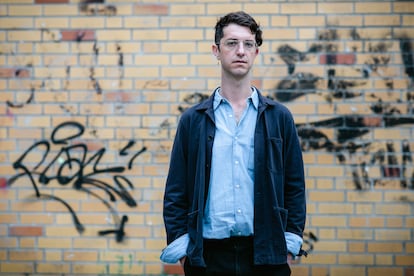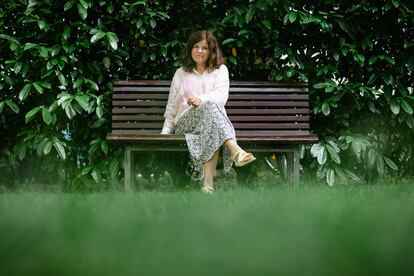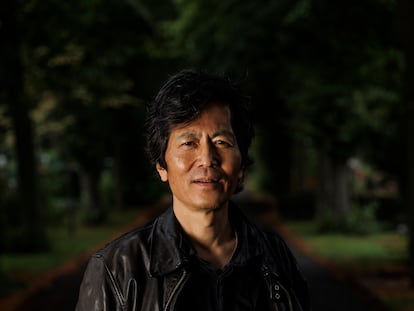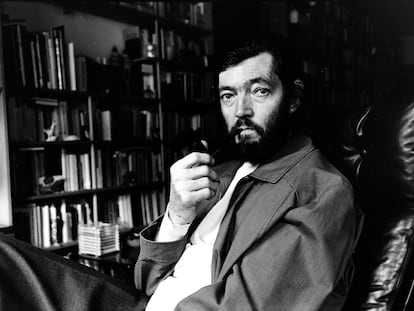Wild gentrification, undercurrents and sex work: This is the new literature of Berlin
From Kirsty Bell to Vincenzo Latronico, several foreign authors are reflecting the changing identity of the German capital, a city marked by the rising cost of living and the traumatic weight of history

Anna and Tom have a joint account at the bank, but different profiles on Netflix, where — in any case — “the algorithm proposes the same things to them.”
This young couple lives in Berlin. They’re surrounded by fellow creative professionals, who are French, Polish, Portuguese, Belgian, Israeli… and rarely German. In fact, they barely speak German: they wouldn’t know how to ask for help if they needed it. Their circle of friends is precarious and brittle, just like their existence. Anna and Tom consider themselves feminists and committed to social justice, which basically means that they’re concerned about “episodes of racism or sexism that occur in New York.” They claim that they’re bisexual… although he’s never been with a man and she was with a woman only once, “in Tom’s presence.” They only take an Uber if it snows. They never eat tuna. They’re considering moving to Lisbon — the new Berlin in the unstoppable evolutionary chain of urban neoliberalism, only “with Mediterranean food and mild winters.” As victims of a gradual increase in the cost of living — with rent, food prices and nights out all becoming more expensive — they will eventually say goodbye, with a banquet of organic samosas and an electronic CBD inhaler.
For Anna and Tom, gentrification is something that other people do. Although, in reality, the protagonists of The Perfections — a novel by Italian author Vincenzo Latronico — are guilty of all charges. They’re part of the quarter-of-a-million new residents who arrived in Berlin — facilitated by a constant flow of low-cost flights — in the five years between 2012 and 2017, 81% of whom were foreigners. During their years in the capital, the rent-controlled studios gradually gave way to luxury apartments, previously acquired by investment funds that would later sell them at ruthless prices.
“I wanted to set the book in Milan, where I lived before… until I realized that Berlin was the quintessence of a major change that explains why we find the same organic wine bar here as in the Eixample of Barcelona, the Milanese neighborhood of Isola, or the 20th district of Paris,” Latronico notes. He’s a 39-year-old Italian living in Berlin. He chats with EL PAÍS
in a biergarten in his new neighborhood. Previously, he lived in the same place as his characters, on the border between Kreuzberg and Neukölln — the two areas with a high density of knowledgeable young people, districts that were once were home to gasbeiter (or “guest workers,” one of those nice German euphemisms) of mostly Turkish origin. If Latronico moved to Charlottenburg — in the western and more residential end of the city — it was because the apartments actually ended up being cheaper there than in the old working-class neighborhoods.

In Kreuzberg, rents rose by 71% between 2007 and 2016. That endless city of Berlin — that of vacant apartments at ridiculously low prices — is a thing of another time. “Space had stopped being limitless,” writes Latronico, as if emulating the North American colonists who, upon encountering the Pacific, understood that the myth of abundance would collapse at some point. Not coincidentally, the working title of The Perfections was The Plenty.
Is the same phenomenon happening in Berlin, which seems to be gradually losing its status as the continent’s alternative capital, as well as its distinctiveness in an increasingly homogeneous European landscape? “Yes, but… isn’t [every place] losing all its specificity? Aren’t you and I losing it? I don’t know you at all, but I’m convinced that our apartments are almost identical, that we read the same books, that I could have arrived at this interview wearing a jacket very similar to yours,” Latronico responds wryly. “The book talks about the gentrification of the city, but also of an internal or mental type of gentrification, in which we’re both victims and perpetrators. What’s happening to Berlin is also happening inside of us.”
Mold stains painted the walls like an abstract painting. One morning, she woke up to a puddle on the kitchen floor, condemning Kirsty Bell to a new life full of buckets, basins and leaks. The British writer and art critic — who has lived in Berlin since 2001 — decided to look for the source of all the water that was sliding down the walls of her majestic 19th-century building, located on the bank of the Landwehr Canal, not far from where the Berlin Wall once separated the city. When they finally fixed her pipes, it was too late: she was immersed in the research that would lead her to write The Undercurrents (2022), halfway between a personal testimony and a cultural history of the city, based on the underground water that circulates through its intestines.
Using her window as a starting point — with the channel of the canal always in the foreground — she explored the lives of the residents in her building, the teachings of Walter Benjamin, Franz Hessel and Rosa Luxemburg, as well as the mysteries hidden in the incongruous landscapes in the vicinity of the building. “I never wanted to write another book about Berlin, because there may already be too many. But, in the 20 years that I’ve been here, the city has changed a lot and very quickly. I would say that many writers try to understand what has happened over the years, to find meaning in something that doesn’t have any.” She reflects on this in the offices that she occupied at the end of a silent street, where you can only hear — every four minutes — the whistle of the above-ground subway.

Bell discovered that Berlin was built on a quagmire. “Things tend to disappear in a city built on bog,” she writes. “Does that explain the strange lethargy that sometimes hangs over the city?” Berlin was not named after the bear that the municipality would later adopt as a mascot, as many tend to believe. Rather, the name is a derivation of the Slavic word for swamps (brlø). And that etymology, Bell assures her readers, represents “a double source of shame” for Berliners, because of how unnoble the image was and because it emphasizes the eastern roots of the city… always less distinguished, supposedly, than the Prussian ones.
It doesn’t seem that this prejudice — typical of another time — has been overcome. In 2008, the city proceeded to demolish the Palace of the Republic, the socialist parliament of the former German Democratic Republic (East Germany). In its place, a replica of the Royal Palace — the former seat of the Hohenzollern dynasty — was erected, at a cost of 680 million euros ($715 million). Some, like Kirsty Bell, consider the structure to be the cornerstone of “some pretty serious historical revisionism.” The palace’s undercurrents also function as symbols of the repression that abounds in its adopted city.
The new literature of Berlin has been moving away from the parameters of another time, from the ravages of Nazism, the post-war fracture and the laborious reunification. It now offers a more precise snapshot of the contemporary city. In many cases, the depiction is being done by foreign authors, who settled in Berlin and became privileged observers of those resounding changes — changes that they themselves were partially responsible for.
Bell isn’t surprised that the writers who are changing the literary reflection of Berlin aren’t German. “When I wrote [the book], I was very aware of my status as an outsider regarding Germany’s culture, history and language. On the other hand, my children are German. Although it’s not my own past, it’s now part of my family history. I’m in the middle,” she reflects.
She explains that a native of the city, for example, wouldn’t have been surprised by the existence of the so-called Berliner zimmer — angular rooms with an incomprehensible, irregular geometry. Bell solved the mystery: in the bourgeois architecture of the 19th century, its function was to unite the facades of buildings — full of light and intended for the wealthy classes — with the perpendicular wings, with smaller and darker floors where the less fortunate lived. Hundreds of awkward triangles abound in the Berlin landscape.
Two new graphic novels — also written by non-German authors who live, or used to live, in Berlin — give further twists to the city’s identity. Hinterhof — by Anna Rakhmanko from Russia and Mikkel Sommer from Denmark — tells the true story of a dominatrix named Dasa Hunk. Upon arriving in the German capital, she threw herself into music, cinema, art... and sex work. “In Berlin I could live the life I’d always dreamed of,” she says in the book, which reaffirms the city’s libertine reputation. Another comic — Hypericon, by Italian graphic novelist Manuele Fior — tells the story of a young Italian woman who arrives in a free, turn-of-the-century Berlin, to work on an exhibition of Tutankhamun’s tomb. In the city, she meets Ruben — a trashy punk who hides the cell phone that his father forces him to carry — who calls her religiously every Sunday. He lives in one of those squat houses that will later become luxury hotels. The author seems to insinuate that the counterculture of the time already carried within it the seeds of its own destruction: some of its members were posh people who pretended to live poorly, as a rite of passage.
Those days are far away. The so-called mietendeckel — or the five-year rent freeze approved by the Senate of Berlin — ultimately only lasted a few months: in 2021, the legislation was ruled unconstitutional and revoked. Berlin — according to the consulting firm Juniper Research — has just been chosen as “the smartest city” in the world, one that “best uses digital solutions for its inhabitants and their businesses.” Digital nomads, willkommen.

Julia Franck isn’t a foreigner, but she knows very well what it feels like to be one. “When I was young — especially before the wall fell — I didn’t feel at home in Berlin or in Germany,” she tells EL PAÍS. She sits on the terrace of a café in her neighborhood, Schöneberg: the former cradle of queer culture in the city. Born in 1970 in East Berlin, the writer was eight-years-old when she moved to the West with her family. They arrived in the Marienfelde refugee camp, where she set her novel West (2015). The family later lived in a country house in the northern state of Schleswig-Holstein. At the age of 13, she managed to get some friends of her mother — an unstable actress — to take her into their home, so that she could attend high school in Berlin. There, she discovered the disdain that West Germans had towards East Germans.
Her latest book — The Stranger I Am — is an autobiographical story that begins in May of 1992, in a small Berlin apartment filled with books and social welfare documents. It jumps back and forth in time to narrate the passage of childhood to adulthood. “Something very strange happened: over the years, I began to find that this place resembled me. Now, I would say that my life couldn’t have happened in any other city, perhaps because Berlin is full of scratches and scars, blank spaces and impossible mixes. At 20-years-old, I wouldn’t have believed it, but everything I see in the architecture of this city, I also recognize in myself.”
Sign up for our weekly newsletter to get more English-language news coverage from EL PAÍS USA Edition
Tu suscripción se está usando en otro dispositivo
¿Quieres añadir otro usuario a tu suscripción?
Si continúas leyendo en este dispositivo, no se podrá leer en el otro.
FlechaTu suscripción se está usando en otro dispositivo y solo puedes acceder a EL PAÍS desde un dispositivo a la vez.
Si quieres compartir tu cuenta, cambia tu suscripción a la modalidad Premium, así podrás añadir otro usuario. Cada uno accederá con su propia cuenta de email, lo que os permitirá personalizar vuestra experiencia en EL PAÍS.
¿Tienes una suscripción de empresa? Accede aquí para contratar más cuentas.
En el caso de no saber quién está usando tu cuenta, te recomendamos cambiar tu contraseña aquí.
Si decides continuar compartiendo tu cuenta, este mensaje se mostrará en tu dispositivo y en el de la otra persona que está usando tu cuenta de forma indefinida, afectando a tu experiencia de lectura. Puedes consultar aquí los términos y condiciones de la suscripción digital.
More information
Últimas noticias
Most viewed
- Sinaloa Cartel war is taking its toll on Los Chapitos
- Oona Chaplin: ‘I told James Cameron that I was living in a treehouse and starting a permaculture project with a friend’
- Reinhard Genzel, Nobel laureate in physics: ‘One-minute videos will never give you the truth’
- Why the price of coffee has skyrocketed: from Brazilian plantations to specialty coffee houses
- Silver prices are going crazy: This is what’s fueling the rally











































